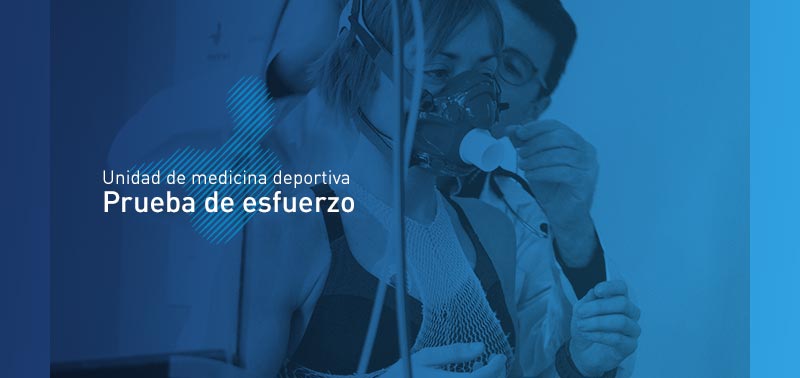
The stress test is a test that everyone who practices a physical activity, regardless of the sport they practice and level thereof, whether professional, amateur or simple enthusiast, should undergo at least once every now and then.
It is also very important for persons undergoing cardiovascular rehabilitation to perform a stress test to ensure the good progress of their process.
What does the stress test consist of?
We can perform the test on a treadmill or stationary bicycle. Depending on the sport practiced by the patient or their needs we will choose one or the other. Usually and in the case of triathletes we recommend doing the test on a treadmill, since it allows us to reach a higher heart rate because it requires greater muscular effort, in addition to extrapolating data more easily.
During the test we perform an electrocardiogram, due to which before the test we will place a series of electrodes around the heart on their different faces and will record the oxygen saturation levels and blood pressure.
During the gas stress test we also wear a mask that will allow us to analyse the athlete’s breathing (oxygen inspired and CO2 expelled, in addition to the amount of air mobilised).
The test has a duration of approximately 15-20 minutes, although it depends on the protocol we decide to apply, wherein we will progressively increase intensity at certain intervals to see how the heart reacts, until reaching the maximum stress level or maximum heart rate.
Stress test and gas analysis
The gas stress test provides us with additional physiological information that we can use to prepare our training sessions:
MAXIMUM HEART RATE:
This test will allow us to calculate training loads as a % of heartbeats or know at what speed we will reach our maximum running frequency.
VO2max:
Maximum consumption of oxygen that our body can process. The greater the volume, the greater the physical resistance capacity to sustained stress, this data will allow us to determine the aerobic resistance level.
AEROBIC THRESHOLD (VTh1):
It provides information such as the number of heartbeats per minute and speed as of which changes take place in our body. Below these levels of intensity we do not generate any improvement in our performance. So you can understand it better, it is the speed at which we feel comfortable training and which we can endure for extended periods of time.
ANAEROBIC THRESHOLD (VTh2):
Point at which the oxygen supply becomes insufficient in relation to its demand and we being to feel fatigued and lactic acid builds up in our body. The number of heartbeats will range between 80-85% of our maximum heart rate, although this depends on our fitness.
These data will allow us to determine the approximate maximum speed at which we can run without becoming fatigued or what rates ensure quality training.
VE (MAXIMUM VENTILATION L/MIN)
It refers to the amount of air mobilised during maximum stress, which will give us an idea of our lung capacity.
LACTIC ACID:
We can determine the level of lactic acid by simply pricking our earlobe or finger, in order to learn the degree of acidity of our organism in accordance with work intensity. It is a very important data to be jointly analysed with the trainer or athlete in question, in order to perfectly adapt the training in accordance with the objectives set.
MAXIMUM TREADMILL SPEED (KM/H) OR MAXIMUM CYCLING EFFORT (WATTS)
It refers to evaluating the maximum load performed which will give us an idea of its physical condition, both from a cardiovascular and muscular viewpoint.
¿What is it for??
The objective of the stress test is mainly clinical, i.e. to assess the heart’s response when subjected to major and even maximum stress levels (around 170-190 beats/minutes) and ensure that everything functions properly, that there are no cardiovascular alterations that could condition the sports practice or imply cardiovascular risk and, if any, resolve them.
Another objective of the stress test is physiological, i.e. to determine the athlete’s capacity to exercise and their characteristics at physiological level, since everyone is different. This will allow us to adapt training level, intensity and load in accordance with the results obtained in the test, which will allow us to improve our sports performance.
Why is it important to undergo a stress test?
The benefits of physical activity for our physical and psychological health are well known. It reduces the risk of suffering cardiovascular diseases, helps us to control our weight, strengthen bones and muscles, improve our state of mind, reduce stress,… and other benefits that make physical activity an almost compulsory practice in our routine.
But it is equally important to perform the physical activity safely, since there is no point in practicing sports if we compromise our health. The stress test makes it possible to detect symptoms or pathologies that do not appear when resting.
Therefore, the stress test is a medical act of utmost importance both from the CLINICAL and PHYSIOLOGICAL viewpoint, in order to minimise the cardiovascular risks and obtain parameters to apply to the training. We will determine both the protocol and type of ergometer to be used in accordance with the previous interview we will hold.



